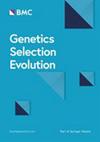Co-occurring microbial guilds in pig fecal microbiota: key drivers and effects on host performance
IF 3.1
1区 农林科学
Q1 AGRICULTURE, DAIRY & ANIMAL SCIENCE
引用次数: 0
Abstract
The pig gut microbiota is a complex ecosystem composed of microbial guilds that remain largely unexplored. Here we decomposed the pig fecal microbiota of two cohorts of 648 healthy Duroc pigs during the transition (n = 400) and growing finish (n = 248) periods in co-occurring bacterial guilds defined as pig enterosignatures (ES). Our results indicate that fecal microbial ecosystems can accurately be described by combinations of at least six ES, driven by the Prevotella (ES-Prev), Treponema (ES-Trep), Lactobacillus (ES-Lact), Clostridium (ES-Clost), Streptococcus (ES-Strep), and UBA2810 (ES-UBA2) genera. We observed a dynamic shift with age in the composition of ES, where ES-Prev, ES-Strep, and ES-Lact seem to be core components. Our results suggest partial genetic control by the host, with heritabilities of ES composition ranging from 0.24 to 0.36. Furthermore, our findings indicate that stress on the host is associated with assembly of the ES, decreasing ES-Lact abundance, and increasing prevalence of ES-Strep. We noted a positive association of ES-Prev with growth rate at 60-days, which later evolved to become negative, impacting feed efficiency during the growing period. Remarkably, a negative association of the abundance of ES-Lact with levels of hair cortisol was also found during this period. Our findings provide novel insights into the pig gut microbiota and reveal novels associations with relevant porcine physiological and performance traits. Moreover, while the ES concept has proven valuable in dissecting microbial communities into assemblies of underlying microbial guilds, our results emphasize the relevance of customizing microbial interventions strategies based on the nutritional and health requirements at each stage of the porcine production cycle.猪粪便微生物群中共存的微生物群落:对宿主生产性能的关键驱动因素和影响
猪肠道微生物群是一个复杂的生态系统,由微生物行业组成,在很大程度上仍未被探索。在这里,我们分解了两组648头健康杜洛克猪在过渡期(n = 400)和生长育肥期(n = 248)的粪便微生物群,这些细菌群被定义为猪肠道特征(ES)。我们的研究结果表明,粪便微生物生态系统可以通过至少6种ES的组合来准确描述,这些ES由普雷沃菌属(ES- prev)、螺旋体属(ES- trep)、乳杆菌属(ES- lact)、梭菌属(ES- clost)、链球菌属(ES- strep)和UBA2810属(ES- uba2)驱动。我们观察到ES的组成随年龄的变化而动态变化,其中ES- prev, ES- strep和ES- lact似乎是核心成分。我们的结果表明,寄主有部分遗传控制,ES组成的遗传力在0.24 ~ 0.36之间。此外,我们的研究结果表明,对宿主的胁迫与ES的组装、ES- lact丰度的降低和ES- strep的患病率增加有关。我们注意到ES-Prev与60天的生长率呈正相关,随后逐渐变为负相关,影响生长期的饲料效率。值得注意的是,在此期间还发现ES-Lact的丰度与头发皮质醇水平呈负相关。我们的研究结果为猪肠道微生物群提供了新的见解,并揭示了与猪相关生理和生产性状的新联系。此外,虽然ES概念已被证明在将微生物群落分解为潜在微生物公会的集合方面具有价值,但我们的研究结果强调了根据猪生产周期每个阶段的营养和健康需求定制微生物干预策略的相关性。
本文章由计算机程序翻译,如有差异,请以英文原文为准。
求助全文
约1分钟内获得全文
求助全文
来源期刊

Genetics Selection Evolution
生物-奶制品与动物科学
CiteScore
6.50
自引率
9.80%
发文量
74
审稿时长
1 months
期刊介绍:
Genetics Selection Evolution invites basic, applied and methodological content that will aid the current understanding and the utilization of genetic variability in domestic animal species. Although the focus is on domestic animal species, research on other species is invited if it contributes to the understanding of the use of genetic variability in domestic animals. Genetics Selection Evolution publishes results from all levels of study, from the gene to the quantitative trait, from the individual to the population, the breed or the species. Contributions concerning both the biological approach, from molecular genetics to quantitative genetics, as well as the mathematical approach, from population genetics to statistics, are welcome. Specific areas of interest include but are not limited to: gene and QTL identification, mapping and characterization, analysis of new phenotypes, high-throughput SNP data analysis, functional genomics, cytogenetics, genetic diversity of populations and breeds, genetic evaluation, applied and experimental selection, genomic selection, selection efficiency, and statistical methodology for the genetic analysis of phenotypes with quantitative and mixed inheritance.
 求助内容:
求助内容: 应助结果提醒方式:
应助结果提醒方式:


